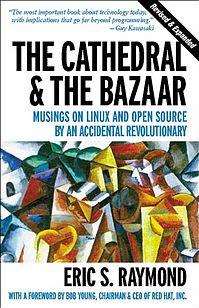 Cover of the paperback compendium edition | |
| Author | Eric S. Raymond |
|---|---|
| Publisher | O'Reilly Media |
Publication date | 1999 |
| Pages | 241 |
| ISBN | 1-565-92724-9 |
| OCLC | 42420737 |
Dewey Decimal | 005.4/32 21 |
| LC Class | QA76.76.O63 R396 1999 |
| Website | www |
The Cathedral and the Bazaar: Musings on Linux and Open Source by an Accidental Revolutionary (abbreviated CatB) is an essay, and later a book, by Eric S. Raymond on software engineering methods, based on his observations of the Linux kernel development process and his experiences managing an open source project, fetchmail. It examines the struggle between top-down and bottom-up design. The essay was first presented by the author at the Linux Kongress on May 27, 1997 in Würzburg (Germany) and was published as part of the same‑titled book in 1999.
The illustration on the cover of the book is a 1913 painting by Liubov Popova titled Composition with Figures and belongs to the collection of the State Tretyakov Gallery.[1] The book was released under the Open Publication License v2.0 in 1999.[2]
The essay contrasts two different free software development models:
The essay's central thesis is Raymond's proposition that "given enough eyeballs, all bugs are shallow" (which he terms Linus's law): the more widely available the source code is for public testing, scrutiny, and experimentation, the more rapidly all forms of bugs will be discovered. In contrast, Raymond claims that an inordinate amount of time and energy must be spent hunting for bugs in the Cathedral model, since the working version of the code is available only to a few developers.
Raymond points to 19 "lessons" learned from various software development efforts, each describing attributes associated with good practice in open source software development:[3]
In 1998, the essay helped the final push for Netscape Communications Corporation to release the source code for Netscape Communicator and start the Mozilla project; it was cited by Frank Hecker and other employees as an outside independent validation of his arguments.[4][5][6] Netscape's public recognition of this influence brought Raymond renown in hacker culture.[7]
When O'Reilly Media published the book in 1999 it became one of, if not the first, complete, commercially distributed books published under the Open Publication License.[2]
Marshall Poe, in his essay "The Hive", likens Wikipedia to the Bazaar model that Raymond defines.[8]Jimmy Wales himself was inspired by the work (as well as arguments put forward in pre-Internet works, such as Friedrich Hayek's article "The Use of Knowledge in Society"), arguing that "It opened my eyes to the possibility of mass collaboration".[9]
In 1999 Nikolai Bezroukov published two critical essays on Eric Raymond's views of open source software, the second one called "A second look at The Cathedral and the Bazaar".[10][11][12][13] They produced a sharp response from Eric Raymond.[14]
Frank had done his homework, citing Eric Raymond's paper, "The Cathedral and the Bazaar," and talking to people in departments throughout the organization--from engineering to marketing to management.
(Since it always gets mentioned in relation to Netscape's Mozilla decision, I should also note that Eric Raymond's paper "The Cathedral and the Bazaar" was referenced by me and others who were lobbying Netscape's management. In my opinion the paper's importance in the context of Netscape's decision was mainly that it provided some independent validation of ideas that were already being actively discussed and promoted within Netscape. If you've ever tried to promote a proposal within your organization, then you may have discovered that it's somewhat easier to do this if you can point to someone outside the organization who's saying the same thing.)
When Netscape CEO Jim Barksdale cited Raymond's 'Cathedral and the Bazaar' essay as a major influence upon the company's decision, the company instantly elevated Raymond to the level of hacker celebrity. Determined not to squander the opportunity, Raymond traveled west to deliver interviews, advise Netscape executives, and take part in the eventual party celebrating the publication of Netscape Navigator's source code.
By: Wikipedia.org
Edited: 2021-06-18 15:10:04
Source: Wikipedia.org